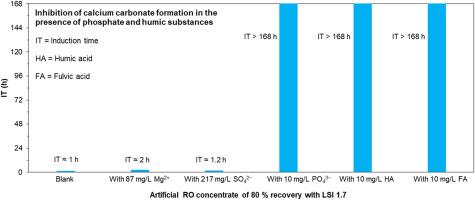Journal of Environmental Chemical Engineering ( IF 7.4 ) Pub Date : 2021-05-14 , DOI: 10.1016/j.jece.2021.105651 M. Nasir Mangal , Sergio G. Salinas-Rodriguez , Bastiaan Blankert , Victor A. Yangali-Quintanilla , Jan C. Schippers , Walter G.J. van der Meer , Maria D. Kennedy

|
The role of phosphate and humic substances (HS) in preventing calcium carbonate scaling and their impact on antiscalant dose was investigated for a reverse osmosis (RO) system treating anaerobic groundwater (GW) (containing 2.1 mg/L orthophosphate and 6–8 mg/L HS).
Experiments were conducted with the RO unit (treating anaerobic GW), and with a once-through lab-scale RO system (operating with artificial feedwater). Additionally, (batch) induction time (IT) measurements were performed with, i) real RO concentrate, and ii) artificial RO concentrates in the presence and absence of phosphate and HS.
It was found that at 80% recovery (Langelier saturation index (LSI) 1.7), calcium carbonate scaling did not occur in the RO unit when the antiscalant dose was lowered from 2.2 mg/L (supplier’s recommended dose) to 0 mg/L. The IT of the real RO concentrate, without antiscalant, was longer than 168 h, while, at the same supersaturation level, the IT of the artificial concentrate was approximately 1 h. The IT of the artificial concentrate increased to 168 h with the addition of 10 mg/L of phosphate, humic acid (HA), and fulvic acid (FA). Furthermore, in the lab-scale RO tests, the normalized permeability (Kw) of the membrane decreased by 20% in 2-h period when fed with artificial concentrate of 80% recovery containing no phosphate, whereas, with phosphate, no decrease in Kw was observed in 10-h period.
These results indicate that phosphate and HS present in the GW prevented calcium carbonate scaling in the RO unit and reduced the use of commercial (synthetic) antiscalants.
中文翻译:

磷酸盐和腐殖质在控制地下水反渗透系统中碳酸钙结垢中的作用
针对反渗透(RO)系统处理厌氧地下水(GW)(含2.1 mg / L正磷酸盐和6–8 mg / kg磷酸盐/腐殖质)的过程中,研究了磷酸盐和腐殖质(HS)在防止碳酸钙结垢中的作用及其对防垢剂剂量的影响。L HS)。
实验使用反渗透装置(处理厌氧GW)和一次性实验室规模反渗透系统(使用人工给水)进行。另外,在以下条件下进行(批量)诱导时间(IT)测量:i)真正的RO浓缩物,和ii)在存在和不存在磷酸盐和HS的情况下的人工RO浓缩物。
结果发现,当防垢剂的剂量从2.2 mg / L(供应商的推荐剂量)降低到0 mg / L时,在80%的回收率(Langelier饱和指数(LSI)1.7)下,RO单元中不会发生碳酸钙结垢。没有防垢剂的实际反渗透浓缩液的IT值长于168 小时,而在相同的过饱和水平下,人造浓缩液的IT值约为1 小时。通过 添加10 mg / L的磷酸盐,腐殖酸(HA)和黄腐酸(FA),人造浓缩液的IT增至168小时。此外,在实验室规模的RO测试中,归一化磁导率(K w)该膜的当用不含磷酸盐的80%恢复的人工浓缩进料在2小时期间减少了20%,而,用磷酸,以K没有减少瓦特在10小时期间进行了观察。
这些结果表明,GW中存在的磷酸盐和HS阻止了RO装置中碳酸钙的结垢,并减少了商业(合成)防垢剂的使用。











































 京公网安备 11010802027423号
京公网安备 11010802027423号